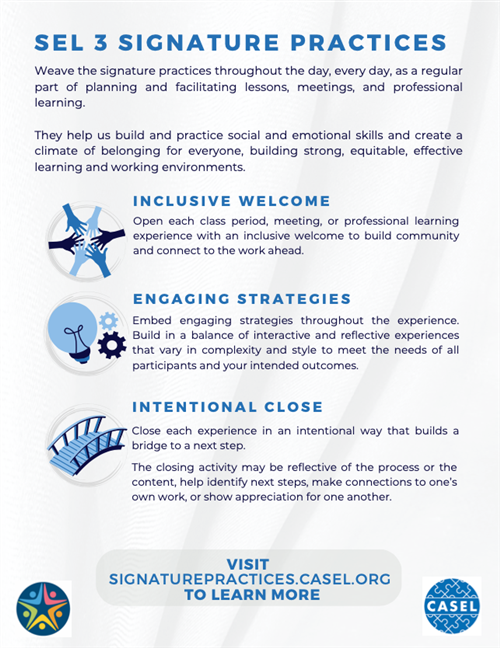- Washoe County School District
- Social Emotional Learning
- Resources
- 3 Signature Practices
Multi-Tiered System of Supports
Page Navigation
-
3 Signature SEL Practices
The SEL 3 Signature Practices were developed in response to these frequently asked questions. Grounded in CASEL’s SEL framework and focal constructs of SEL, these practices are an accessible starting place for do-able, effective systemic SEL. While they can appear simple, they provide opportunities for influencing complex systems in significant ways.
Weave the signature practices throughout the day, every day, as a regular part of planning and facilitating lessons, meetings, and professional learning. These research-based practices can be part of a systemic approach to SEL. They help us build and practice social and emotional skills and create a climate of belonging for everyone, building strong, equitable, effective learning and working environments.
INCLUSIVE WELCOME
Open each class period, meeting, or professional learning experience with an inclusive welcome.
An inclusive welcome is culturally and linguistically respectful, builds community, and connects to the work ahead. When planning and facilitating activities, educators are always thinking, “What’s my purpose?” The inclusive welcome is an opportunity to bring that purpose to life. What to a casual observer might appear to be an icebreaker or time-filler can be an intentional, effective educational strategy.
ENGAGING STRATEGIES • Sense Making and “Brain Breaks”
Embed engaging strategies throughout the experience.
Engaging strategies offer opportunities for participants to more fully grasp content and to connect learning to their own contexts. Build in a balance of interactive and reflective experiences that vary in complexity and style to meet the needs of all participants and your intended outcomes for the time together.
INTENTIONAL CLOSE • Reflections and Looking Forward
Close each experience in an intentional way that builds a bridge to a next step.
An intentional close highlights an individual and shared understanding of the content and purpose of the engagement, illuminates the intellectual and emotional experience just shared, can provide a sense of accomplishment, and supports forward-thinking. The closing activity may be reflective of the process or the content, help identify next steps, make connections to one’s own work, or show appreciation for one another.
-
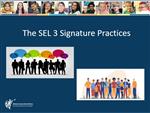
Ready to Go Slide Deck
Access slides that are ready to use for integrating the SEL 3 Signature Practices into school communities.
-
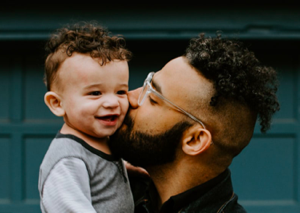
3 Signature SEL Practices Video
Social Emotional Learning (SEL) Signature Practices to Support Students, Families and Educators
-
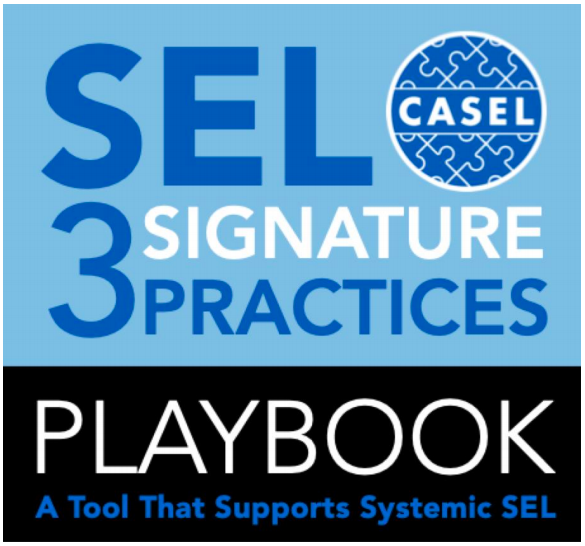
3 Signature Practices Playbook
PRACTICAL WAYS TO INTRODUCE AND BROADEN
THE USE OF SEL PRACTICES IN CLASSROOMS, SCHOOLS AND WORKPLACES -
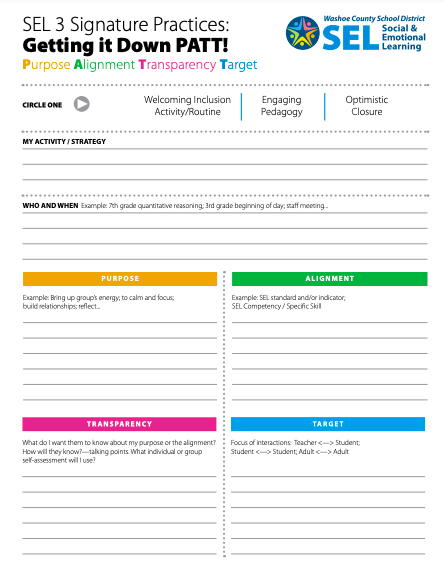
Getting it Down PATT - Fidelity Check
Use this tool to enhance fidelity of the 3 Signature Practices (Purpose, Alignment, Transparency, Target.)
Choose an SEL Theme and Explore!
-
Courage
Courage is doing the right thing, even when it is hard. When you have courage, it doesn’t mean that you aren’t afraid. Having courage means that you push those fears aside to do what is right. You make choices that help you be your best self, making life better for you and for others around you.
WELCOMING ROUTINES/OPTIMISTIC OPENERS • Activities for Inclusion
- Write the word “courage” and draw 3 things that show what it means to you.
- Pick your favorite superhero. Explain how they are courageous.
- Exercise your courage! Pick something new that you could try today.
- Who do you know that is courageous? How do they show courage?
- Why should people be courageous?
ENGAGING PEDAGOGY • Sense Making and “Brain Breaks”
- STAR” Breathing (See additional resources)
- Play rock, paper, scissors with someone in your home. First to 5 games/wins.
- Try and rub your belly with your right hand while patting the top of your head with your left hand. Can you switch?
- Balloon breathing (See additional resources)
- Create a dance. Give your dance a name and teach it to someone! Do they have a dance they can teach you?
REFLECTIVE CLOSER • Reflections and Looking Forward
- How can you help someone be courageous?
- How have you or a friend shown courage today? Try and identify 1-3 courageous moments.
- What does it feel like to be courageous?
- Draw something you did today. Did you practice being courageous?
- Describe a courageous moment.
-
Gratitude
Gratitude is thankfulness. When you show gratitude, you take the time to be thankful for the people and things in your life. There is always something to be grateful for and when you stop and find things to be grateful for, you develop an “Attitude of Gratitude.” This positive attitude can improve your life and the lives of others around you.
WELCOMING ROUTINES/OPTIMISTIC OPENERS • Activities for Inclusion
- Write the word gratitude on a piece of paper. Decorate the paper with acts of gratitude.
- Create a list of things that inspire you in nature. Pick one and explain why you are thankful.
- Identify something difficult. What are some positives surrounding that difficulty?
- Write 3 things that you are excited about for the future. Pick two and explain why they excite you.
- “The more grateful I am the more beauty I see.” What does this mean to you?
ENGAGING PEDAGOGY • Sense Making and “Brain Breaks”
- Pretzel” Breathing (See additional resources)
- Pick a food you like and pretend you are the chef cooking it. Act it out!
- Play a game of head, shoulders, knees and toes! How fast can you go?!?
- Rub your belly with your right hand while patting the top of your head with your left hand. Can you switch?
- STAR Breathing (See additional resources)
REFLECTIVE CLOSER • Reflections and Looking Forward
- Identify 1-3 people you are grateful for. Explain why you are grateful for them.
- Today is a new holiday focused on gratitude. What is the new holiday called? What happens throughout the day for participants to show gratitude?
- Write down 1-3 things that you like about yourself. Explain why you are thankful for these characteristics.
- Write 1-3 things that you “had to do” today. Now explain why it is important that you had the chance to “get to do” them. Share your list with someone.
- What are you grateful for this week? How does it feel to express gratitude?
-
Compassion
Compassion in action is the understanding of a problem or the suffering of another and acting to solve the problem or alleviate the suffering. When you show compassion in action, you step outside yourself to do something to connect with others and help better their situation or lives, whether physically or mentally.
WELCOMING ROUTINES/OPTIMISTIC OPENERS • Activities for Inclusion
- What does compassion mean to you? Identify 3-5 ways to show compassion.
- List some ways to show compassion. Pick one act of compassion and complete it.
- Say something nice to someone. How do you feel? How does it feel when someone says something nice to you?
- If compassion were an animal, what animal would it be? Why?
ENGAGING PEDAGOGY • Sense Making and “Brain Breaks”
- “Pretzel” breathing (see additional resources)
- Create a kindness doodle. Give it to a friend.
- 5,4,3,2,1: Wiggle your toes 5 times, shrug your shoulders 4 times, make arms circles 3 times, squeeze your hands into a ball 2 times, do 1 jumping jack (repeat as many times as needed).
- “Drain” breathing (see additional resources)
- Pick you 3 favorite animals and act out how they go through their day.
REFLECTIVE CLOSER • Reflections and Looking Forward
- Why is it important to be positive? What impact does it have on you and others?
- Think of your favorite book, movie, or TV show; how do some of the characters care for others in the story? Tell a friend or journal about it.
- Reflect on your day: Write down all the times you helped someone today. See how long of a list you can make. Acts of kindness can be simple and easy!
- Trace your hand on a paper. In the fingers, write 5 compassion words. In the palm, draw what your favorite word for kindness looks like.
- How has compassion shaped your words and actions this week? What acts of compassion did you use this week? How did they impact others around you? How did they make you feel?
-
Identity
Identity is who you are. Your identity includes your name, likes and dislikes, your beliefs, your thoughts, your personality, and culture. Remember, culture may include age, race, religion, gender, music, family traditions, food, language, where you live, and anything else that makes you who you are! Each person has a special identity. Learning about your identity improves self-awareness.
WELCOMING ROUTINES/OPTIMISTIC OPENERS • Activities for Inclusion
- Create a list of things that make you special.
- If you had a special power, what would it be? Why?
- What is your favorite movie/book/TV show? How are you like one of those characters?
- What is your favorite song? What do you like about that song? Sing or write down the lyrics.
- What is your favorite hobby? What do you like to do with your free time?
ENGAGING PEDAGOGY • Sense Making and “Brain Breaks”
- Wiggle Dance- play some music and get the “wiggles” out.
- Balloon Breathing (See additional resources)
- Balance a pen or pencil on your pointer finger. Can you add more objects? OR Stand on each foot for at least 15 seconds. Then try it with your eyes closed. Now try it with your hands touching above your head. Can you balance on each foot with your eyes closed AND your hands above your head?
- 5,4,3,2,1: Wiggle your toes 5 times, shrug your shoulders 4 times, make arm circles 3 times, squeeze your hands into a ball 2 times, do 1 jumping jack (repeat 3 times).
- STAR Breathing (See additional resources)
REFLECTIVE CLOSER • Reflections and Looking Forward
- Write your full name and ALL your nicknames. What is special about your name? What does your name mean? Where does your name come from? (Optional: Hang it up for all to see!)
- Complete the sentence: I love my_______________ (repeat 3 times).
- Create a poem or song that celebrates who you are and why you are special. Share with someone.
- What makes you most proud? What goals and dreams do you have? THINK BIG!!
- Reflect on your week. Did you learn anything new about yourself? What do you like most about yourself?
-
Organization
Organization helps you prepare for the future. It helps you plan activities and daily routines. Journals can help organize our thoughts. Desks can help organize school supplies; closets can help organize clothes. Organization helps you focus on what is important. It helps you reach your goals.
WELCOMING ROUTINES/OPTIMISTIC OPENERS • Activities for Inclusion
- Create a list of 3 things you need to do today. Put them in order from most important to least. Try to finish your list before the day ends.
- Create a T-Chart for your daily routine. In one column put your activities. In the other column, write down how much time you will spend on each activity. Place your T-Chart where you can see it every day to remind you of your routines. (see additional resources for an example)
- What helps you stay organized? Make a list.
- Think of your favorite character from a show, book or movie. How do they stay organized? How could that character improve their organization?
- Create a SMART goal. (see additional resources for an example)
ENGAGING PEDAGOGY • Sense Making and “Brain Breaks”
- Toe Wiggles: Try wiggling your toes from your pinky toe to your big toe. Now, wiggle from the big toe to the pinky toe. See what other ways you can mix it up!
- PUZZLE MAYHEM! Get out a sheet of paper (any size will work). Draw anything you want on the paper. Make the drawing big, and use up the whole piece of paper. Now, rip the paper up into 10 pieces and mix them up. See if you can put your “puzzle” back together. Ask someone at home to rebuild your puzzle with you.
- Create a dance. Give your dance a name. Teach someone your dance! Do they have a dance they can teach you?
- Paper Toss: Crumple up a piece of paper and toss it from one hand to the other. Then, try it with one hand behind your back, tossing it over your shoulder. Switch hands.
- Pretzel Breathing (see additional resources)
REFLECTIVE CLOSER • Reflections and Looking Forward
- Work through those challenges or difficulties tomorrow if they come up?
- Create a song about organization. Sing it to a friend.
- What would your favorite cartoon character say about organization?
- Find something you can organize. A backpack, a closet, a pile of movies, a drawer, a cupboard…anything works! How does it feel now that you finished?
- Reflect on your week, and rate your organizing skills from 1-5 (1 needing improvement and 5 is amazing). Why did you give yourself that rating? What can you do to improve your organization?
-
Determination
Determination is a quality that makes you continue trying to do or achieve something that is difficult. Determination is working through challenges. It helps you make decisions to problem solve.
WELCOMING ROUTINES/OPTIMISTIC OPENERS • Activities for Inclusion
- What do you want to finish today? How are you determined to finish?
- Think about the today and fill in the blanks: I want to____________________________. I can ____________________________. I will ____________________________.
- What might be a challenge for you today? How will you work through it?
- A growth mindset means that you believe you can improve with effort. How will you use a growth mindset today? Growth Mindset for K-2 (episode 1 of 5) OR Growth Mindset for 3-5
- What does finishing mean to you? How does it feel to finish something you have started?
ENGAGING PEDAGOGY • Sense Making and “Brain Breaks”
- Balloon Breathing (see additional resources)
- Humdinger: Hum your favorite tune! Move while you hum. OR Pretend you are a character from your favorite book or show. Act out a scene.
- Drain Breathing (see additional resources)
- Make a cheer or chant to celebrate when you reach a goal. Does your cheer or chant have moves to go with it?
- 5,4,3,2,1- roll your head in a circle 5 times each way, take 4 deep breaths, clench your hands 3 times, take 2 deep breaths, hug yourself once and take one deep breath. (Repeat as many times as needed)
- Try saying this tongue twister quickly 3 times: “Give papa a cup of proper coffee in a copper coffee cup.”
REFLECTIVE CLOSER • Reflections and Looking Forward
- How did you use determination to get through your day
- What did you accomplish today? Celebrate! Find a time to share with someone!
- What steps did you take to work through a challenge today?
- How did you use your growth mindset today? What did it feel like to get better with something that challenges you?
- What did you finish this week? Celebrate your determination by creating a song, dance or poem!
-
Emotions
Emotions are your reactions to the world around you. Some emotions include joy, surprise, sadness, fear, and anger. Naming emotions helps you understand and respond to them. When you pay attention to your emotions, understand your feelings and responses this is called self-awareness.
WELCOMING ROUTINES/OPTIMISTIC OPENERS • Activities for Inclusion
- As you start your day what emotions do you notice?
- Share a happy moment with someone. What was the memory about?
- Think of a time when you felt afraid. Who or what helped you not feel so afraid? Write or think about something that gives you strength.
- If you had to stay inside or outside all day and could do anything you wanted, how would you spend your time? Share your thoughts with someone.
- When have you been surprised? What is the most exciting thing you have ever done?
ENGAGING PEDAGOGY • Sense Making and “Brain Breaks”
- Pretzel Breathing (see additional resources)
- Sing a song about joy. Can you make your own song about joy?
- Bird, Snake, Bear, and Kangaroo- pick an animal and pretend to be that animal for 30 seconds. (repeat as many times as needed with different animals)
- STAR Breathing (see additional resources)
- Snap Wink: Wink your left eye and snap your right hand at the same time. Then wink your right eye and snap your left hand at the same time. Switch back and forth as fast as you can.
REFLECTIVE CLOSER • Reflections and Looking Forward
- What emotions did you feel today? How did you respond to your emotions?
- When you are happy, what do you do? When you are sad or angry, what helps you feel comfort?
- How can you surprise someone tomorrow? What act of kindness will you complete for yourself or someone else?
- Think of your favorite character in a book or cartoon. What kind of responses do they show to their emotions when they are happy, surprised or angry?
- Think about your week. How did you respond your emotions? Did your response feel good? Would you change anything for next week?
-
Mindfulness
Mindfulness is when you focus your attention on the present moment. This is a way to practice self-awareness by paying attention to your body, thoughts, feelings, and surroundings. Being mindful requires us to be in-tune with ourselves.
WELCOMING ROUTINES/OPTIMISTIC OPENERS • Activities for Inclusion
- Think about the word, “mindful.” Think about what mindfulness might look like for you. What are some ways you can be mindful? (Ex. breathing exercises, noticing smells, tastes, sounds around you and how it makes you feel)
- Look or step outside. Use your senses to write details about the world around. (What does it look like, feel like, smell like?)
- What is your favorite food? What does it feel like to eat that food? What do you like most about it?
- Take a deep breath. Close your eyes if you want. Slow your breathing down. What do you notice about your heartbeat? Now, be active for 30 seconds. What do you notice about your heartbeat? Write about the difference in your heartbeat when you were calm and after you were moving.
- Describe what a mindful moment looks like for you. How can practicing mindfulness help you learn?
ENGAGING PEDAGOGY • Sense Making and “Brain Breaks”
- STAR Breathing (see additional resources)
- Snap Wink: Wink your left eye and snap your right hand at the same time. Then wink your right eye and snap your left hand at the same time. Switch back and forth as fast as you can.
- Make a fist. Breathe out into your fist where your thumb meets your point finger. Think about what it feels like inside your fist as you breathe. How does breathing into your fist feel on your lips?
- Balloon Breathing (see below in additional resources)
- Airplane, Truck, Boat, Train! Pretend you are a vehicle and move around like that vehicle, make the noises of that vehicle, or both!
REFLECTIVE CLOSER • Reflections and Looking Forward
- Discuss/write about some ways that you were mindful today. What did it feel like in your mindful moments?
- Describe how being mindful can help you feel more relaxed. List some examples from today.
- How could you help someone else to be mindful? What could you do together to practice?
- What was your favorite mindful moment? Why? What did you see, smell, taste, hear, feel?
- How has practicing being mindful helped you through your week? What effect did it have on how you treated others?
-
Friendship
Friendship is a way to connect with someone in your life. Friends are people that you trust, and you know will be there for you. Friends help each other. Friends have special bonds and can share ideas that help them stay connected. Friendships are important relationships for everyone.
WELCOMING ROUTINES/OPTIMISTIC OPENERS • Activities for Inclusion
- If there was one thing you could change about the world what would it be and why? Whose help would you need to make that change?
- How are you a good friend to others? How are others a good friend to you? Make a list of what makes someone a good friend.
- What are all the different ways you can call someone “friend”? (Example: buddy, amigo)
- If you had three wishes to help a friend, what would they be?
- What is your favorite game to play with a friend? What do you like about that game?
ENGAGING PEDAGOGY • Sense Making and “Brain Breaks”
- What is your dream job? Pretend you are that person! Act out what your favorite job does during their day.
- STAR Breathing (see additional resources)
- Pretend you are an astronaut in space or a deep-sea diver. Act out a mission to the moon or to the bottom of the ocean.
- Pretzel Breathing (see additional resources)
- Body Alphabet: Form letters of the alphabet from A to Z using your body. Challenge;pretend the alphabet is backwards. Can you perform your body alphabet in reverse Z to A?
- Say this tongue twister 3 times fast: “Give papa a cup of proper coffee in a copper coffee cup.”
REFLECTIVE CLOSER • Reflections and Looking Forward
- What did you learn about friendship this week? Did you make any new friends? Did you become closer friends with someone than you weren’t before? How?
- How are you and your friends alike? How are your friends different from you?
- If you could make your friend a gift that they would love, what would you make? What would you need to make that gift?
- How did you help someone today? What did it feel like to help that person?
- Create an acrostic poem for the word “FRIEND.” Draw a picture for your poem or describe what that picture would look like.

